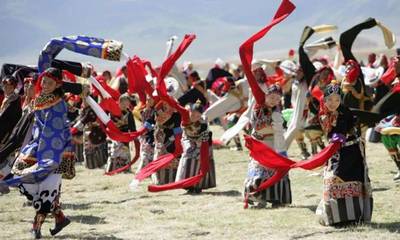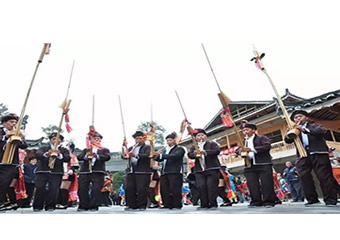The Ethnic Music of the Dong Ethnic Group in China
Dong people inhabit Guizhou, Hunan and Guangxi provinces of China. They are a creative ethnic group. As the saying goes, "Dong's culture is composed of three treasures: the Drum Tower,Ka Lau and flower bridges."Of them,the Drum Tower and flower bridges are famous constructions, whereas Ka Lau is an intangible folk music that can only be enjoyed by the ears and touched by the hearts.Since almost all Dong people are good at singing, their native place is honored as the "ocean of songs." Out of their performances,the most famous is Ka Lau that makes an impact in the world circle of songs.

Dong people commonly call Dong's Ka Lau as Kgal Laox. "Kgal" refers to songs, while "Laox" means grand and ancient. Ka Lau is a unique multi-part,non-director and a cappela chorus, in which one performer leads the chorus,while other three to five singers form a male or female voice part. Its main theme is sung by the base section,whereas the treble part is derived from voices. The base part is present by a number of singers in a loud voice;while a small group of performers, mostly one to three,sing the treble part,where they recreate their singing in random on the basis of the melody of the base part.
Dong's Ka Lau features rhymed lyrics and graceful tones. Its lyrics are mostly composed by means of comparison and metaphor, demonstrating a profound implication and eulogizing nature, labor work, love and friendship. Since Ka Lau is derived from natural sounds, the songs are usually enhanced with bird chirps and babbling brooks.Apart from exercises in leisure time, more Ka Lau performances are presented in the Drum Tower, a landmark building in the Dong's village, in festivals or at events.
All Ka Lau performers have an accurate command of absolute pitch. In a chorus, all of them sound the intonation of the same tone, making a sense of the pitch that could be compared with professional chorus troupes. They can make it because they have had strict training since childhood. Their parents taught them children's songs at an early age and sent them to a folk-song master at about 10 years of age. Although the master teaches them free of charge,they had to perform rigorous exercises. They learned the lyrics and then the musical notations in different singing groups according to their gender and age. On that basis, the master selected singers according to their vocal sounds and give them additional lessons. And over time, they have a good grasp of absolute pitch and skills of folk songs after learning in groups and from a master.




